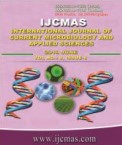


 National Academy of Agricultural Sciences (NAAS)
National Academy of Agricultural Sciences (NAAS)

|
PRINT ISSN : 2319-7692
Online ISSN : 2319-7706 Issues : 12 per year Publisher : Excellent Publishers Email : editorijcmas@gmail.com / submit@ijcmas.com Editor-in-chief: Dr.M.Prakash Index Copernicus ICV 2018: 95.39 NAAS RATING 2020: 5.38 |
Field demonstration trials on efficacy of Pseudomonas fluorescens and Azotobacter sp. against Meloidogyne incognita were carried out in six different farmers’ fields viz., Namtemera, Kakodunga, Naromari and Misimiati in Golaghat district, Kamalabari in Majuli district and Dichangmukh in Sivasagar district of Assam that were infested by root knot nematode, Meloidogyne incognita. The farmers of each location were educated with the demonstration technique of enrichment and soil application methods of P. fluorescens and Azotobacter sp. enriched in enriched compost @ 1% (1ton enriched compost /ha) on the field. The demonstrated technique i.e. P. fluorescens and Azotobacter sp. enriched in enriched compost @ 1% (1ton enriched compost /ha) was compared with existing farmers technique as untreated control. Analyzed data reveal that, application of P. fluorescens and Azotobacter sp. enriched in enriched compost was found to be best in increasing the plant growth parameters viz., shoot and root length (cm), number of nodules per root system and yield (q/ha) of black gram and decreasing nematode infection (number of galls and egg masses) and multiplication (nematode population in soil) than untreated control. However, the yield of black gram in demonstration fields was ranged from 6.15-8.80q/ha whereas in untreated control it ranged from 4.50-5.70 q/ha. The percent increase in the yield with improved practice over control was recorded in the range of 36.67-66.00 %. The technology and extension gap ranged between 3.70-6.35 q/ha and 1.65-3.30 q/ha and it emphasized the need to educate the farmer’s through various means for the adoption of improved / recommended production technology to decrease the gaps. Similarly, the technology and extension index were ranged between 29.60-50.80 % and 26.83-39.76% which are on lower side indicating greater scope for adoption of new techniques by the farmers. The benefit-cost (B :C) ratio in each location was found to be favorable which ranged from 1: 1.5 to 1: 2.03 and this higher benefit cost ratio indicates economic viability of the demonstrated technology among the farmers.
 |
 |
 |
 |
 |